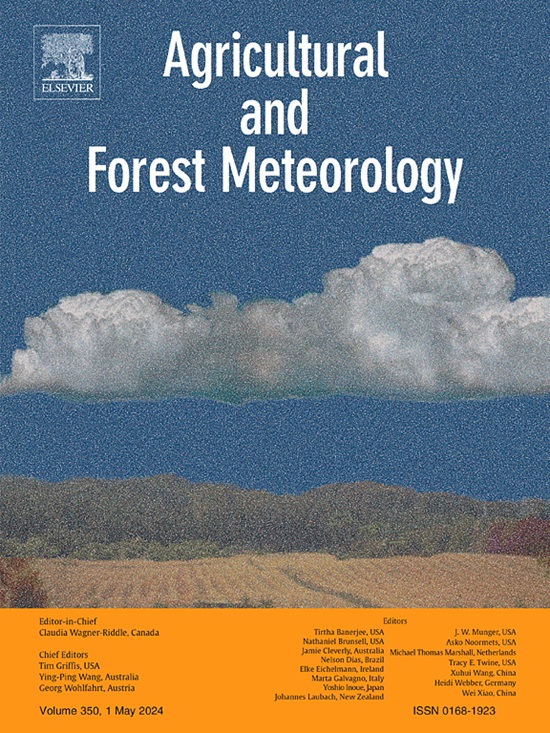茎干直径变化中的霜冻干旱迹象
IF 5.7
1区 农林科学
Q1 AGRONOMY
引用次数: 0
摘要
霜冻干旱是指树木扎根于寒冷或冰冻的土壤中,在高蒸发压力下发生的慢性或急性干燥。这种现象已经存在了一个多世纪,但其特征还很不明显。夏季干燥表现为茎干长期收缩。冬季也有类似收缩的报道。在这项研究中,我们利用瑞士阿尔卑斯山常绿(P.abies)和落叶(L.decidua)成熟树木沿海拔横断面(从 800 米到 2200 米)生长的 14 年树干测定仪数据,调查了冬季茎干总收缩(WSC)的原因。结果表明,WSC 在 30μm30μm 和 1478μm1478μm 之间变化,与树种、海拔和树高密切相关。此外,收缩的程度与冻融事件(ΔΔF)后的茎干收缩密切相关。我们认为,ΔΔF和WSC都是霜冻干旱造成的冰冻阻塞导致水分损失的结果,当树木的远端部分解冻并进行蒸腾时,较大的基部部分仍处于冰冻状态,从而抑制了水分吸收并造成水力失衡。本文章由计算机程序翻译,如有差异,请以英文原文为准。
Signs of frost drought in stem diameter variations
Frost drought refers to the chronic or acute desiccation of trees exposed to high evaporative pressures while being rooted in cold or frozen soils. This phenomenon has been known for more than a century but is still poorly characterized. Summer desiccation manifests itself as long-term stem contractions. Similar contractions have been reported in winter. In this study, we investigated the causes of total winter stem contraction (WSC) using 14 years of dendrometer data from evergreen (P.abies) and deciduous (L.decidua) mature trees growing along an elevational transect (from 800 to 2200 m asl) in the Swiss Alps. Results indicated that WSC varied between and and were strongly dependent on species, elevation, and tree height. Moreover, the magnitude of contractions was strongly associated with stem contractions subsequent to freeze–thaw events (F). We suggest that both F and WSC are the consequences of water losses due to ice blockage associated frost drought, occurring when the distal parts of the tree are thawed and transpiring, while the larger basal parts remain frozen, thus inhibiting water uptake and creating a hydraulic imbalance.
求助全文
通过发布文献求助,成功后即可免费获取论文全文。
去求助
来源期刊
CiteScore
10.30
自引率
9.70%
发文量
415
审稿时长
69 days
期刊介绍:
Agricultural and Forest Meteorology is an international journal for the publication of original articles and reviews on the inter-relationship between meteorology, agriculture, forestry, and natural ecosystems. Emphasis is on basic and applied scientific research relevant to practical problems in the field of plant and soil sciences, ecology and biogeochemistry as affected by weather as well as climate variability and change. Theoretical models should be tested against experimental data. Articles must appeal to an international audience. Special issues devoted to single topics are also published.
Typical topics include canopy micrometeorology (e.g. canopy radiation transfer, turbulence near the ground, evapotranspiration, energy balance, fluxes of trace gases), micrometeorological instrumentation (e.g., sensors for trace gases, flux measurement instruments, radiation measurement techniques), aerobiology (e.g. the dispersion of pollen, spores, insects and pesticides), biometeorology (e.g. the effect of weather and climate on plant distribution, crop yield, water-use efficiency, and plant phenology), forest-fire/weather interactions, and feedbacks from vegetation to weather and the climate system.

 求助内容:
求助内容: 应助结果提醒方式:
应助结果提醒方式:


